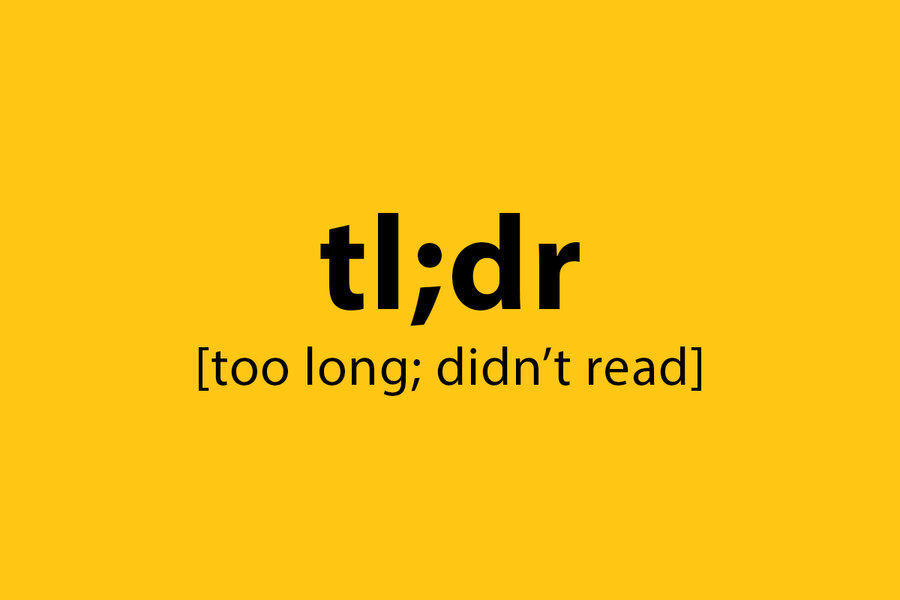tldr meaning or Too Long; Didn’t Read,” is an internet acronym commonly used to quickly summarize long pieces of writing or content online. By giving readers an outline of an extensive piece, allows them to quickly grasp its main points without diving deep into each passage or discussion thread. In this article, we explore its history, development and relevance today.
Brief History of “TL;DR”
The concept of TL;DR has its origins in online forums and communities where users gather to engage in discussion and share information on various issues. With technology evolving and people no longer having time or interest in reading lengthy articles/blog posts/articles for various topics; people began creating concise summaries using the acronym “TL;DR” to signify how succinct their summaries were.
At its core, “TL;DR” stands for “Too Long; Didn’t Read.” This term serves to acknowledge that certain readers found the original text too long for them and so provided condensed versions as shorter overviews for them to review. When to Use TL;DR
The use of the acronym has grown far beyond online forums and discussions to be applied in an array of situations:
1. Online Articles and Blogs
A TL;DR summary can often be found at the start of longer blogs or articles to give readers a quick snapshot of its contents so that they can decide if reading all of it would be worthwhile – an effective tactic used by websites to engage readers while decreasing bounce rates.
2. Academic Papers
In academia, TL:DRs are more commonly known as abstracts. They provide a succinct summary of major findings, methodology and conclusions in research papers so researchers can quickly ascertain whether an article fits within their field of research. Abstracts allow them to quickly access potential relevant papers for further consideration by others conducting similar work.
Also Read: integers-definition-rules-properties-and-examples
3. Social Media
Social media sites have taken advantage of TL;DR to draw people’s attention away from an overwhelming sea of information. Users can post brief summaries of articles or subjects they feel could benefit their followers’ understanding, in order to spark conversation or educate.
4. Email Communication
In professional environments, individuals often utilize TL;DR in email exchanges as an efficient method to summarise lengthy reports or messages and ensure key points are understood without having to go through each document in its entirety.
5. Review and Recommending Platforms
Review websites frequently include quick overviews to quickly assess the quality of services, films or books; these summaries allow users to make educated decisions without reading extensive reviews.
Writing an Effective TL;DR
Producing an excellent TL:DR requires skill; it needs to convey all of the essential aspects of its original text succinctly yet clearly. Here are some guidelines for producing outstanding TL;DRs.
Search Out Key Ideas or Arguments or Conclusions Spend some time carefully reading or skimming the text, paying particular attention to its key ideas, arguments or conclusions.
Keep it brief The ultimate aim for any TL;DR is conciseness – usually only one or two sentences and/or paragraph.
Make use of clear language When writing the summary for your document, ensure it uses language which allows for instant comprehension. This ensures a timely comprehension.
Be Objective For best results, aim at providing an unbiased overview in your TL;DR document. Avoid injecting personal opinions or bias into its creation.
Maintain Accuracy Your summary should accurately represent both its main components and tone from original source content.
Engage Your Reader When appropriate, an attention-getting hook or assertion may help get their attention and keep it.
Information Consumption With so much online information readily available today, users face an ongoing struggle between managing time or attention span and staying current with news. That is where TL:DR comes into its own: as an effective tool that allows quick evaluation of its relevancy or importance quickly and effectively.
Also Read: understanding-ip-addresses-definition-and-explanation
Pros of TL;DR
Efficiency: By giving users an overview, TL;DR can save them time by helping them decide whether or not to read through all the material presented.
Content Filtering This technology enables users to eliminate irrelevant or unimportant information and focus on that which matters to them.
Accessibility: TLDR makes complex or lengthy topics simpler for wider public consumption and helps disseminate knowledge more broadly.
Cons of TL;DR
Potential Misrepresentation
A biased or inaccurate summary may distort the message completely and result in misinterpretations or incorrect interpretations.
Failed Understanding: Relying solely on short and easy reading may only lead to superficial understanding of complex subjects without all their subtleties and details.
Low Engagement While TL;DR can save time, it may prevent readers from engaging with content which requires greater thought or study.
“TL;DR in Everyday Life
Although originally developed for use on the internet, “TL.DR” has quickly become an everyday colloquial term among friends and family to indicate an efficient summary of a topic or event without delving too deeply into details. People frequently use it either humorously or casually when communicating key aspects of events quickly without getting bogged down with unnecessary detail.
An individual might say: I watched the TL;DR version of that movie and thought it seemed like an exciting action flick.” In such situations, “TL:DR” serves as a useful shorthand to convey their impression in concise form.
Future of TL;DRs
As digital continues its rapid transformation, so will its use. Thanks to artificial technology and automation we may witness AI-generated summarizers which provide content more rapidly. However, fairness and accuracy remain essential components in summarization processes.
conclusion,
At its heart, TL;DR is now an indispensable element of online communications, helping users effectively navigate digital content and navigate it efficiently. While its time-saving access may prove advantageous to some extent, users must still remain wary to avoid missing key pieces of data or being drawn into misleading reports that may contain falsehoods. In essence, TL;DR embodies digital’s ever-evolving way of digesting data, where conciseness reigns supreme and information overload reigns supreme.
